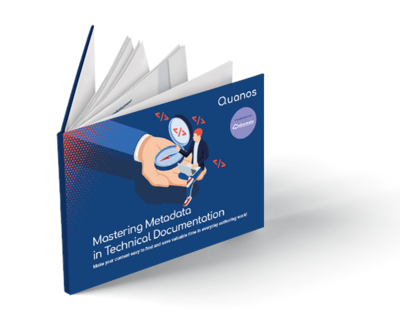Metadata in Technical Documentation
The amount of data stored in your technical writing department grows with every new target language and every new product variant. So how can technical writers maintain a clear overview and quickly find the information they need? The solution lies in metadata. Read on to discover the advantages of metadata and learn why it is indispensable for automatically creating operating instructions in technical documentation.

What role does metadata play in technical documentation?
Metadata describes data. In technical writing, component content management systems in particular use metadata to classify information modules such as texts, graphics, and illustrations. But even technical writers who do not use any special software subconsciously follow the same principles when naming a file in a certain way; a key term for the content, the current date, and the version in the file name also constitute metadata in a broader sense.
What metadata exists in technical writing?
Metadata can include information such as:
- Text type (instructive, descriptive, warning)
- Product validity (e.g., for variant A)
- Relevance in a specific phase of the product’s life cycle (such as maintenance)
- Target audience (service technicians, for example)
- Formal information like the creation date, translation status, approval, author, etc.
Why is metadata important in technical documentation?
Metadata provides clarity in a document database that would otherwise be difficult to navigate in many technical writing departments. It also saves a great deal of time, as personally “viewing” information modules to understand their content is very time-consuming and often even impossible with large quantities of data.
Without metadata, technical writing departments may encounter the following problems:
- Chaos in document management
- A lack of overview with respect to changes and versions, which in turn poses compliance risks
- Time wasted searching for documents
- Deteriorating quality as the risk of errors increases
Metadata is a must – especially when companies serve multiple target markets or offer a range of different product variants. But transparency in the document database is not the only advantage of working with metadata in technical documentation. It is very difficult and sometimes literally impossible to realize many projects without it, as we’ll discover in the next section.
What advantages can be gained from metadata in combination with a content management system?
In a content management system, you create content modules such as individual images, graphics, and text sections. This principle is known as modularization. If these content modules are tagged with metadata, it’s very easy for you to find them again at a later time using the search and filter function. You can then reuse content modules that have already been produced, for example to automatically create operating instructions and other documents in a predefined layout. This saves time and keeps redundant content to a minimum. With modular content, you can:
- Produce publications for specific target groups: Using the filter function, you can select content that is aimed at a specific target group (such as service technicians or consumers) to create differentiated documentation.
- Generate maintenance plans: It’s possible to filter not only by target group, but also by the relevant phase in the product life cycle,
enabling you to create maintenance plans at the touch of a button. - Produce publications about specific product variants: As your product range grows, you can draw on existing content that also applies to a new variant. This means you only need to create new content that relates specifically to the new product.
Metadata is also indispensable when it comes to other uses of your technical documentation:
- Search function on internet portals: Product users and service technicians benefit from performing a convenient, targeted search on an online platform where they can access the contents of the technical documentation.
- Chatbots: If you wish to offer a chatbot so that users or service technicians can interact with your technical documentation, accurate results are dependent on metadata.
Your in-house technical writers also benefit from:
- Overview of the edit status: You will never again lose track of a document’s version, translation, or approval status.
- Lower translation costs: You can easily identify content that hasn’t yet been translated – allowing you to send only this content off to your translators and avoid translating identical content more than once.
- Identification of duplicates: You can use metadata to locate identical content modules and remove duplicates. This eases your administrative workload and is particularly useful during data migration.
Users of a content management system for technical documentation can better exploit the potential of their software if they work with metadata. However, they do not have to assign all of this manually, because as a rule the content management system automatically tags modules with certain metadata, such as the author's name, approval and translation status, and the creation and modification dates.
Why do some technical writers struggle with metadata?
Reason 1: Introducing a metadata model takes time
Implementing metadata in technical writing requires both a strategy and a metadata model. After all, in order for metadata to be truly useful it must be assigned consistently across the team. The topic is often considered too complex and/or too unwieldy to even tackle.
Tip: Firstly, limit yourself to metadata that is relevant to your daily work and truly necessary for your tasks. With the iiRDS standard, the Association for Technical Communication (tekom) has developed a guide specifically for use in technical writing.
Reason 2: Assigning metadata is considered too time-consuming
Many technical writing departments are under pressure to meet deadlines and some employees don’t see the efficiency gains, just the time required to assign metadata.
Tip: Clarify the advantages of metadata and highlight to colleagues that updating large volumes of metadata is much more time-consuming than assigning it at the same time as creating the content. Make sure that metadata is not disregarded or sloppily created – there’s an option with content management systems to define mandatory fields, but these do not prevent incorrect entries. It helps to encourage motivation and to also check the metadata during the review process, rather than just the content.
Furthermore, the saying “less is often more” definitely applies here. Metadata models should focus on information that actually benefits technical writers or end users in the short term. An overloaded model with too many theoretical fields tends to be off-putting and reinforces the impression of wasted effort.
Reason 3: The content management system is not user-friendly
If assigning metadata is cumbersome and therefore disruptive to a technical writer's everyday workload, this will discourage them from using the feature.
Tip: When selecting a content management system, make sure that assigning metadata with it is a simple and seamless process. Ideally, the software should have an automation function to quickly assign metadata to large amounts of content. The SCHEMA ST4 content management system offers AI Jetpack for assigning metadata as an AI-supported plug-and-play solution.
Conclusion: Gradually implement metadata in technical documentation
Metadata is an investment in the future viability of technical documentation. It not only guarantees greater efficiency in your technical writing and transparency in your document management, it also forms the basis for making operating instructions available to your target groups in a user-friendly way. Furthermore, metadata also lays the foundation for realizing futuristic applications like chatbots. As a technical writer, do not allow potential obstacles to deter you. Instead, get to grips with the subject in phases so that you can benefit from metadata and its advantages in the long term.
White Paper: Mastering Metadata in Technical Documentation

Metadata is the hidden helper in the background that takes you straight to the information you need. It brings order to the vast jungle of data and saves you a great deal of time.
In this white paper, you will learn why metadata is useful in technical writing and read about those situations where you actually cannot do without it. We also dispel some myths and show you how to introduce metadata step by step.


